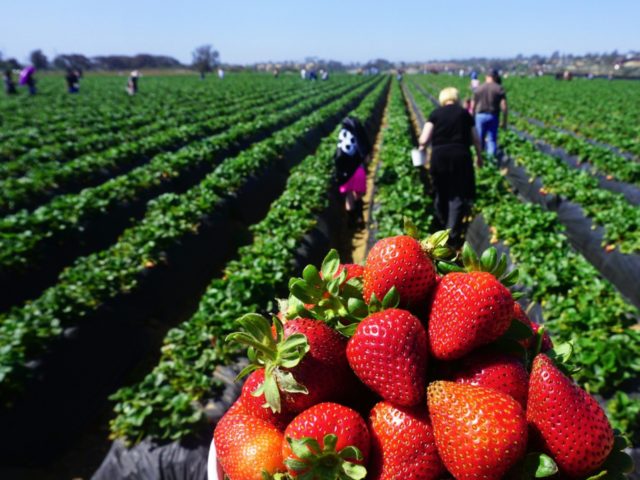A group of Americans is getting $7.5 million from investors to help pick strawberries by using a multi-armed, electronic-eyed robot.
The investment will help field the first robots in Davis, California, said Marc Grossman, CEO of Advanced Farm Technologies. “With this investment, we can expand our lead in robotic strawberry harvesting and continue to innovate in other areas,” he told theRobotReport.com.
Picking ripe fruit is technologically challenging. But the progress is made economically possible because the federal government is not providing farm companies with all of the cheap labor they want, industry officials said. AgFunderNews.com reported:
The saving grace for robotics’ scale-related challenges, however, lies in its most powerful ally. Growers are plagued by labor shortages and searching for solutions that they can deploy today, not a few years down the road, says [investment manager Nolan] Paul.
Paul said:
Right now, there’s probably about eight startups going after the automated harvest of strawberries in different ways. Some of them are in Europe, some are here … Labor challenges are an existential problem for everyone. It’s freaking a lot of people out as something that needs to be solved in the next two to three years as the consequences to the industry will be significant.
The strawberry industry employs a large number of illegal immigrants in Florida and California and is a massive part of each state’s agriculture sector. “In 2017, the United States produced 1.6 billion pounds of strawberries, valued at nearly $3.5 billion,” says the Agricultural Marketing Resource Center.
“Tightening immigration policy and strengthening economies in Mexico and other countries exacerbate this [labor] issue,” says another U.S. company which is developing a strawberry robot, Sunnyvale, Calif.-based Traptic:
By subscribing, you agree to our terms of use & privacy policy. You will receive email marketing messages from Breitbart News Network to the email you provide. You may unsubscribe at any time.
The ability of Americans to build strawberry machines is underlined by a story from 1965 when the U.S. government encouraged high schoolers in California to replace hard-working, high-endurance Mexican pickers. National Public Radio reported the forgotten, one-year episode:
He remembers the first day vividly. Work started before dawn, the better to avoid the unforgiving desert sun to come. “The wind is in your hair, and you don’t think it’s bad,” [Randy] Carter says. “Then you go out in the field, and the first ray of sun comes over the horizon. The first ray. Everyone looked at each other, and said, ‘What did we do?’ The thermometer went up like in a Bugs Bunny cartoon. By 9 a.m., it was 110 degrees.”
…
“If we took a vote that first day, we would’ve left,” he says of his friends. “But it literally became a thing of pride. We weren’t going to be fired, and we weren’t going to quit. We were going to finish it.”
Carter’s group was one of the few that completed their stint, partly because the pay and conditions were also terrible, and Calfornia youth had many preferable summer options, said the NPR report. The government and the farms quickly gave up on the project, so ensuring the massive inflow of Mexicans into California over the next four decades:
“We went through something that you can’t explain to anyone, unless you were out there in that friggin’ heat,” the 70-year-old says. “It could only be lived.”
But he says the experience also taught them empathy toward immigrant workers that Carter says the rest of the country should learn, especially during these times.
“There’s nothing you can say to us that [migrant laborers] are rapists or they’re lazy,” he says. “We know the work they do. And they do it all their lives, not just one summer for a couple of months. And they raise their families on it. Anyone ever talks bad on them, I always think, ‘Keep talking, buddy, because I know what the real deal is.’ “
In Plant City, Fla., Harvest CROO Robotics is developing another robot to replace up to 30 stoop laborers with several technicians and engineers. Many strawberry growers are funding the research, and the developers hope to begin deploying their robot-pickers in late 2019. Up to 2,500 machines will be needed for the industry:
A Spanish firm, Agrobot, has tested its strawberry picked in a California field owned by Driscoll’s, the largest strawberry grower. The Agrobot robots work best when the strawberries are grown in trays a few feet above the ground:
Israel-based FF Robotics is also developing a strawberry robot — and an apple-picking robot for the farm companies in Washington state. In New Zealand, Robotics Plus has developed a robot apple-packer and a robot that can pick kiwi fruit — and may be adapted for apples.
In 2017, Abundant Robots’ apple-picker got $10 million from investors, including Google Ventures. The firm is based in Hayward, California:
The apple industry has also imported huge number of migrants, helping Washington State to follow California’s path towards a one-party state.
Meanwhile, many firms are building “vertical farms” so that many types of high-value crops can be grown in ideal lighting, ideal temperatures, free of pesticides and diseases, and close to workers and customers:
Immigration Numbers:
Each year, roughly four million young Americans join the workforce after graduating from high school or university. This total includes about 800,000 Americans who graduate with skilled degrees in business or health care, engineering or science, software, or statistics.
But the federal government then imports about 1.1 million legal immigrants and refreshes a resident population of about 1.5 million white-collar visa workers — including approximately 1 million H-1B workers and spouses — and about 500,000 blue-collar visa workers.
The government also prints out more than 1 million work permits for foreigners, it tolerates about 8 million illegal workers, and it does not punish companies for employing the hundreds of thousands of illegal migrants who sneak across the border or overstay their legal visas each year.
This policy of inflating the labor supply boosts economic growth for investors because it transfers wages to investors and ensures that employers do not have to compete for American workers by offering higher wages and better working conditions.
This policy of flooding the market with cheap, foreign, white-collar graduates and blue-collar labor also shifts enormous wealth from young employees towards older investors, even as it also widens wealth gaps, reduces high-tech investment, increases state and local tax burdens, and hurts children’s schools and college educations.
The cheap-labor economic strategy also pushes Americans away from high-tech careers and sidelines millions of marginalized Americans, including many who are now struggling with fentanyl addictions.
The labor policy also moves business investment and wealth from the Heartland to the coastal cities, explodes rents and housing costs, undermines suburbia, shrivels real estate values in the Midwest, and rewards investors for creating low-tech, labor-intensive workplaces:



COMMENTS
Please let us know if you're having issues with commenting.